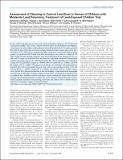| dc.contributor.author | Ettinger, Adrienne S | |
| dc.contributor.author | Bornschein, Robert L | |
| dc.contributor.author | Farfel, Mark | |
| dc.contributor.author | Campbell, Carla | |
| dc.contributor.author | Ragan, N Beth | |
| dc.contributor.author | Rhoads, George G | |
| dc.contributor.author | Brophy, Merrill | |
| dc.contributor.author | Wilkens, Sherry | |
| dc.contributor.author | Dockery, Douglas W. | |
| dc.date.accessioned | 2011-04-28T05:25:51Z | |
| dc.date.issued | 2002 | |
| dc.identifier.citation | Ettinger, Adrienne S., Robert L. Bornschein, Mark Farfel, Carla Campbell, N. Beth Ragan, George G. Rhoads, Merrill Brophy, Sherry Wilkens, and Douglas W. Dockery. 2002. Assessment of cleaning to control lead dust in homes of children with moderate lead poisoning: treatment of lead-exposed children trial. Environmental Health Perspectives 110(12): A773-A779. | en_US |
| dc.identifier.issn | 0091-6765 | en_US |
| dc.identifier.uri | http://nrs.harvard.edu/urn-3:HUL.InstRepos:4878930 | |
| dc.description.abstract | In this article we describe the assessment and control of lead dust exposure in the Treatment of Lead-exposed Children (TLC) Trial, a clinical trial of the effects of oral chelation on developmental end points in urban children with moderately elevated blood lead levels. To reduce potential lead exposure from settled dust or deteriorated paint during the drug treatment phase of the trial, the homes of 765 (98%) of the randomized children (both active and placebo drug treatment groups) were professionally cleaned. Lead dust measurements were made in a sample of 213 homes before and after cleaning. Geometric mean dust lead loadings before cleaning were 43, 29, 308, and 707 micro g/ft2 in the kitchen floor, playroom floor, playroom windowsill, and playroom window well samples respectively. Following cleaning, floor dust lead loadings were reduced on average 32% for paired floor samples (p < 0.0001), 66% for windowsills (p < 0.0001), and 93% for window wells (p < 0.0001). Cleaning was most effective for 146 homes with precleaning dust lead levels above the recommended clearance levels, with average reductions of 44%, 74%, and 93% for floors (p < 0.0001), windowsills (p < 0.0001), and window wells (p < 0.0001), respectively. Despite these substantial reductions in dust lead loadings, a single professional cleaning did not reduce the lead loadings of all dust samples to levels below current federal standards for lead in residential dust. Attainment of dust levels below current standards will require more intensive cleaning and lead hazard reduction strategies. | en_US |
| dc.language.iso | en_US | en_US |
| dc.publisher | National Institute of Environmental Health Sciences | en_US |
| dc.relation.isversionof | http://www.ncbi.nlm.nih.gov/pmc/articles/PMC1241131/pdf/ | en_US |
| dash.license | LAA | |
| dc.subject | chelation | en_US |
| dc.subject | cleanup | en_US |
| dc.subject | dustwipe | en_US |
| dc.subject | environmental exposure | en_US |
| dc.subject | lead dust | en_US |
| dc.subject | lead poisoning | en_US |
| dc.subject | prevention and control | en_US |
| dc.title | Assessment of cleaning to control lead dust in homes of children with moderate lead poisoning: treatment of lead-exposed children trial | en_US |
| dc.type | Journal Article | en_US |
| dc.description.version | Version of Record | en_US |
| dc.relation.journal | Environmental Health Perspectives | en_US |
| dash.depositing.author | Ettinger, Adrienne S | |
| dc.date.available | 2011-04-28T05:25:51Z | |
| dash.affiliation.other | HMS^Medicine-Brigham and Women's Hospital | en_US |
| dash.affiliation.other | SPH^Exposure Epidemiology and Risk Program | en_US |
| dash.affiliation.other | HMS^Medicine-Brigham and Women's Hospital | en_US |
| dash.affiliation.other | SPH^Exposure Epidemiology and Risk Program | en_US |
| dash.affiliation.other | SPH^Environmental Health | en_US |
| dc.identifier.doi | 10.1289/ehp.021100773 | |
| dash.contributor.affiliated | Dockery, Douglas | |
| dash.contributor.affiliated | Ettinger, Adrienne | |


